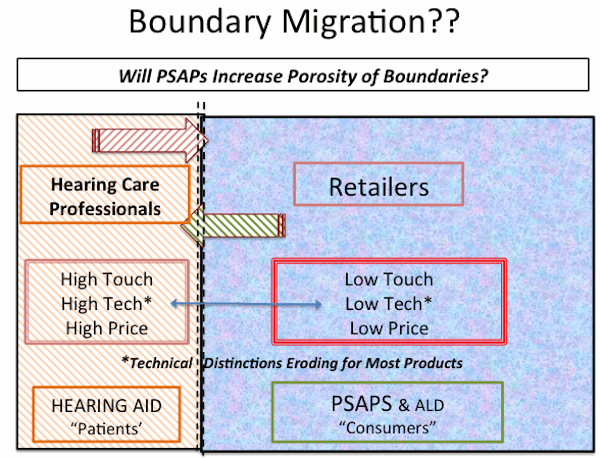Part IV of “Trimming the Sails” by Dr. Christopher Schweitzer is the last post in this series that discusses why hearing aid market penetration fails to meet desired goals. Dr. Schweitzer is Director of HEAR 4-U International; Chief of Auditory Sciences at Able Planet, Inc.; and Senior Audiologist, Family Hearing Centers in Colorado. Wayne Staab, Section Editor
Incubators for Hearing Aid Market Expansion
 Based on our discussion of last week, is it unreasonable to assume that many hearing professionals may find a role in the delivery of personal sound amplification products (PSAPS) as a way to expand their community presence and develop an enlarged database of users benefiting from amplification products? Is it not possible that the right attitude towards PSAPs may allow them to become incubators for the development of new patients with genuine otological/audiological needs? Is this not another prospective outcome from the swirling winds; fearsome change accompanied by unfamiliar opportunity?
Based on our discussion of last week, is it unreasonable to assume that many hearing professionals may find a role in the delivery of personal sound amplification products (PSAPS) as a way to expand their community presence and develop an enlarged database of users benefiting from amplification products? Is it not possible that the right attitude towards PSAPs may allow them to become incubators for the development of new patients with genuine otological/audiological needs? Is this not another prospective outcome from the swirling winds; fearsome change accompanied by unfamiliar opportunity?
PSAPs are devices organized and marketed not for Hearing Loss, but for situational Sound Loss. Understood in the language of engineering Signals and Systems, the intent is to increase the amount of times that a signal is correctly received. In this case it happens to be for short-distance acoustical communication conditions, rather than via satellite or telephone. Perhaps, it is also pertinent to recall that the entire telecom industry was the result of Alexander Bell’s efforts to help his wife Mabel to hear with less effort.
The question for professionals who have understandably preferred the sharp segmentation that separates their high-service delivery model from low-cost commodity products is whether there will continue to be a sufficient demand for all the boats fishing in those waters. Or will the much larger population of PSAP shoppers be viewed as worth making the effort of adjusting the tiller? The answer is likely related to motivational consideration arising from such threats as an erosion of third-party payments and a general decline of average selling price. Enlarging the “scope of practice” to include more retail focus in conjunction with their high-service component is not a path that many hearing aid dispensers will comfortably embrace. But almost certainly, some will morph and transform to deliver a greatly enlarged catalog of hearing help products. Many may well choose to cling to the medical model of expert diagnosticians and hold steady to the familiar course through new and different sea winds, while others will have trimmed their sails for a smoother journey.
Consumer pressure for options1will continue to roil the seas and force adaptations, whether or not professionals are in favor or choose to ignore the market changes. Technological forces that enable low-cost, but high-performance personal amplifiers are potentially genuine game changers that may alter the previously impervious boundaries between Hearing Care Professional offices (High Touch, High Price) and Retail (Low Touch, Low Price) locations. Figure 8 illustrates the type of impact that PSAPs may have on these channel distinctions. Technical differences will continue to be genuine and noteworthy at the higher-end product tiers, but lower and middle-level products will be difficult for consumers and professionals to legitimately distinguish.

Figure 8. Theoretical merging of dispensing ‘boundaries’ that may occur as technology ‘leveling’ occurs in the middle and lower tiers of products.
Summary
Inexorable changes in the delivery of hearing products have created considerable uncertainty in the hearing products community, for consumers, and especially for those whose livelihoods are closely coupled to the sale of hearing aids. Outside observers might note unproductive inter-clan skirmishes among audiologists, dispensers, mail-order, and online marketers. In some cases, unexpected alliances of disparate parties with vested interests have emerged in attempts to hold off the ever-changing supply of new entries, as in manufacturers that forswear online sales while continuously scanning the horizon for new markets.
This treatise has tried to illustrate some previously neglected assumptions that appear to be at work, both in consumer attitude and supply chain realities. These include the frequently heard comment from prospective consumers that among the barriers to hearing aid acquisition is the dislike for the “disability” patina that accompanies the “medical model” of dispensing. Price is often also frequently mentioned, as is accessibility. It is not the intention of this paper to diminish or denigrate the value of the dispensing professional, particularly given that the author has a long career trying to advance that value in his own private dispensing practice.
Numerous studies have shown a very high correlation between consumer satisfaction and the beneficial role of the hearing professional. As many others2,3,4 have argued, the service component is crucial. But it remains unproductive to dismiss the evidence that a very large number of “non-adopters,” as the hearing aid industry refers to them, are evidently warming to the notion of amplification assistance through more accessible, less medical, delivery channels.
The accelerating supply and interest in PSAPs for low-cost entry products constitutes what appears to be a “disruptive” entry into the North American market. But in every disruption lies the prospect for expansion. Indeed, hearing professionals who engage these lower-cost, non-medical devices as tools for connecting with medically averse consumers may well find a prosperous outcome in these ever-changing ocean winds as market expansion tools. PSAPs, it has been argued, may also serve a role in auditory assistance for low-income people and individuals in highly constrained environments, such as nursing homes or assisted living facilities where non-professionally fit, lower-cost options may be attractive augmentative tools for communication and the preservation of cognitive fitness. The interplay of all the players, including manufacturers, consumers, professionals and regulatory influencers / boundary setters, will certainly be interesting to observe in the coming years.
References and Footnotes
1Beck, M. (2012) Testing, Testing …Can you hear better now? Wall Street Journal Sept. 10, Health Journal .
2Ross, M. (2012) Direct to Consumer Services – Comment on the hi Hearing Innovations Hearing Aid Dispensing Program. Hearing Loss Magazine March/April 28-30.
3Van Vliet, D. (2012) Final Word: Price vs Service and the NY Times. Hearing Review. Dec. 1.
4Northern, J. (2012). The Secret is Service: An Historical Perspective on Hearing Aids, PSAPs, and DTC hearing aids. Hearing Review 19(05)16-27.






